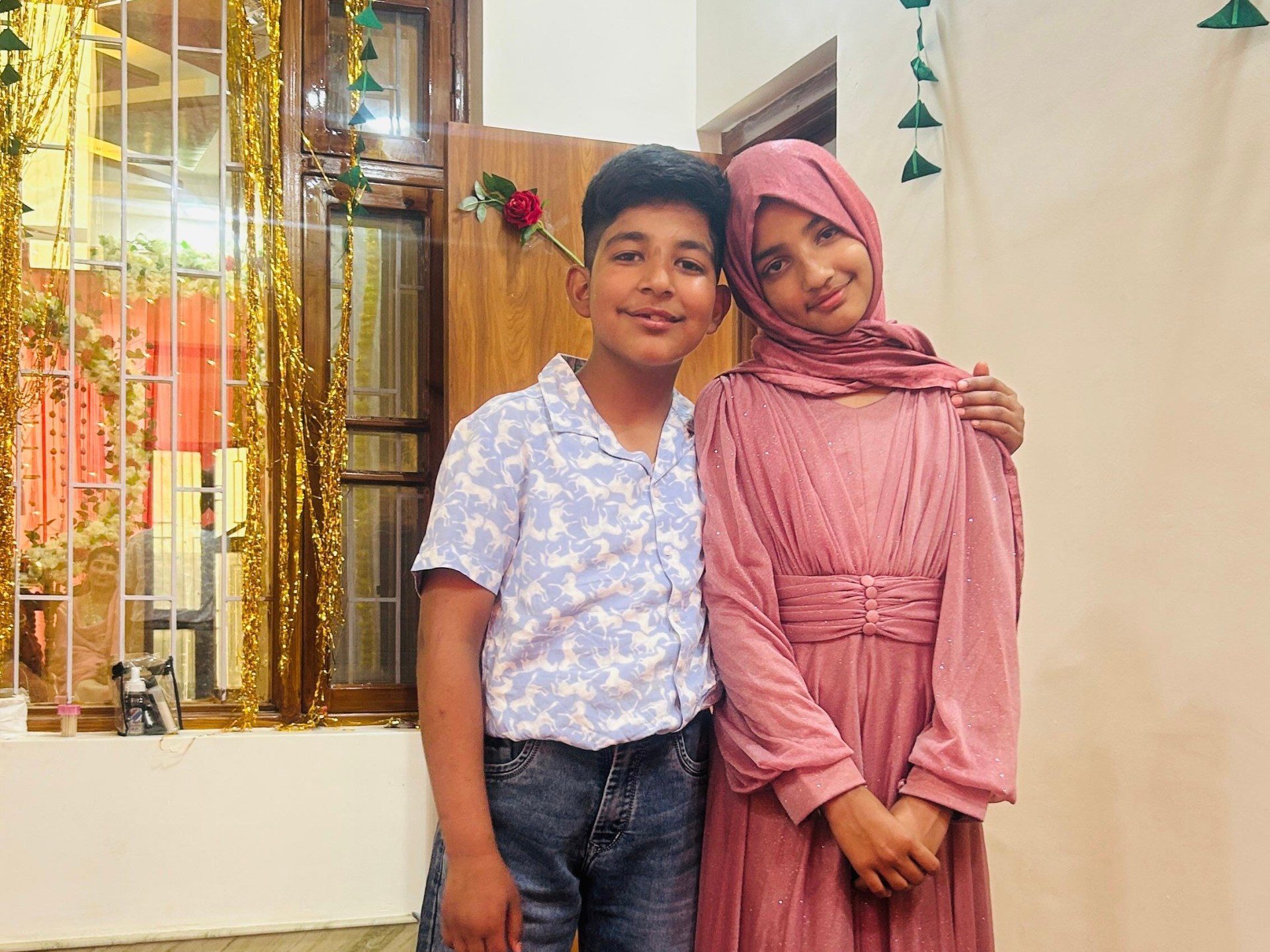Srinagar, Indian-administered Kashmir – Javaid Iqbal opens a photo on his mobile phone. It shows a little girl sporting a pink woollen beanie, a grey trinket slung loosely around her neck – her face beaming in a wide smile.
Five-year-old Maryam, his daughter, who happily posed for the photo only last month. Today, she is no more.
Maryam was killed on the morning of May 7 when an explosive landed on their home in Sukha Katha, a cluster of some 200 homes in Poonch district of Indian-administered Kashmir, some 20km (12 miles) from the Line of Control (LoC), India’s de facto border with Pakistan in the disputed Himalayan region.
“Oh, Maryam,” Iqbal, 36, cries out, clutching the phone to his chest. “This is a loss I cannot live with.”
Maryam was among at least 21 civilians – 15 of them in Poonch – killed in cross-border shelling in Indian-administered Kashmir in early May as the South Asian nuclear powers and historical enemies engaged in their most intense military confrontation in decades. For four days, they exchanged missiles and drones, and stood on the precipice of their fifth war before they announced a ceasefire on May 10.
That truce has since held, even though tensions remain high and both nations have launched diplomatic outreach initiatives to try and convince the rest of the world about their narrative in a conflict that dates back to 1947, when the British left the subcontinent, cleaving it into India and Pakistan.
But for families of those who lost relatives in the cross-border firing, the tenuous peace along the LoC at the moment means little.
“My heart bleeds when I think of how you [Maryam] died in my arms,” wails Iqbal.
‘The earth rattled beneath us’
For decades, residents along the LoC have found themselves caught in the line of fire between India and Pakistan, who have fought three of their four previous wars over Kashmir. Both control parts of the region, with two tiny slivers also administered by China. But India claims all of Kashmir, while Pakistan also claims all of the region except the parts governed by China, its ally.
In 2003, India and Pakistan agreed to a ceasefire along the LoC that – despite frequent border skirmishes and killings of civilians on both sides – broadly held, and was renewed in 2021.
But on April 22, gunmen killed 25 tourists and a Kashmiri pony rider in Pahalgam, a scenic resort in Indian-administered Kashmir, starting the latest chapter in the India-Pakistan conflict over the region.
New Delhi accused Pakistan of backing the gunmen, a charge that Islamabad denied. Since the beginning of an armed rebellion against India’s rule in Indian-administered Kashmir in 1989, New Delhi has accused Islamabad of training and financially supporting the rebels. Islamabad says it only provides diplomatic and moral support to the separatist movement.
On May 7, the Indian military responded to the Pahalgam killings by launching missiles at multiple cities in Pakistan and Pakistan-administered Kashmir. India claimed it struck “terror camps” and killed about 100 “terrorists”. Pakistan said more than 50 people were killed – but most were civilians, with a military personnel also killed.
Pakistan responded with heavy cross-border firing. Iqbal says he was jolted awake at about 2am on May 7 by the sounds of artillery shells landing “one after the other, their thuds rattling the earth beneath us”.
“I made frantic calls to everyone, like police, officials in administration I knew, and on toll-free emergency numbers like 108, pleading with them to rescue me and my family,” he told Al Jazeera. “But no one came.”
He says he huddled his family – his wife, three children and three children of his brother who were with them at the time – in an outhouse abutting their main house, hoping that cinder blocks on top of the structure would make it more resilient to any Pakistani shells.
The explosions kept getting closer.
Shortly after sunrise, he says, a shell whizzed across the mountains, a trail of smoke streaming behind it, and landed with an explosion close to their shelter. Its splinters hurtled in every direction, blasting through the walls behind which Iqbal and his family had sought refuge.
As he squinted through the smoky haze, his eyes rested on Maryam, whose little body was perforated with hot metal shards as she lay listless amid the debris, which was soaked with her blood.
“I called a friend for help. He alerted the administration, who sent an ambulance, which tried to come near our house, but the continuous shelling forced it to return,” he said, adding that the ambulance attempted to come closer five times but could not.
By the time the shelling subsided and they could get to a hospital, Maryam was dead. Her sister, 7-year-old Iram Naaz, was also hit by a splinter in her forehead and is currently recovering in the family’s ancestral village in Qasba, close to the LoC.
A ghost town
The shelling continued in Sukha Katha for three days. Today, it looks like a ghost town, its ominous silence shattered only by the strong gales of wind sweeping through the open doors and windows of empty homes, with curtains fluttering and dust swirling around them.
Most residents who fled the shelling haven’t returned.
“There are about 200 homes here and they are empty because everyone has fled to safety,” said Muhammad Mukhar, a 35-year-old resident. He and a few others remained. “We are just keeping an eye out for thieves. These townspeople are unlikely to return soon because things are still uncertain.”
The villagers have reasons to remain fearful of more attacks, says Kashmiri political analyst Zafar Choudhary. He says the loss of civilian lives on the Indian side of the border in Poonch is due to the “peculiar” topography of the region, which confers a “unique advantage” to Pakistan.
“Most of the towns and villages on the Indian side are situated down in the valleys while Pakistani army posts remain high on the mountain tops, overlooking the civilian habitations here,” he says. “Even if India retaliates, the civilian loss to the Pakistani side would remain minimal. This makes border towns such as Poonch vulnerable.”
At Khanetar, a town of rundown structures of bricks and rebars overhung with life-size advertisements of soda drinks, an asphalt road zigzags through the forests and ravines and links the border areas of Poonch with the plains of Jammu, in the southern part of Indian-administered Kashmir.
In this village, a Pakistani shell explosion killed 13-year-old Vihan Kumar inside the family’s car when they were trying to escape the firing. The boy died on the spot, his skull ripped open.
“It was a loud sound, and at once, my son was in a pool of blood,” recalls Sanjeev Bhargav, Vihan’s father. “We immediately rushed to the district hospital in Poonch, where Vihan breathed his last.” Vihan was the only child of his parents.
‘Naked dance of death’
Meanwhile, at the intensive care unit of the Government Medical College Hospital in Jammu, the second largest city in Indian-administered Kashmir, about 230km (140 miles) southeast of Poonch, Arusha Khan is consoling her husband, Rameez Khan, a 46-year-old teacher, who is battling for his life after shrapnel punctured the left side of his liver.
They are mourning the loss of their twins – son Zain Ali and daughter Urba Fatima – who died in the shelling of their house on May 7. They had turned 12 in April.
The family was cowering inside their home in Poonch when the frightened twins called their uncle, Arusha’s brother Aadil Pathan, who lived in Surankote, in the same district, about 40km (25 miles) away, pleading with him to save them.
“The children were scared to their wits’ end,” Arusha’s sister Maria Pathan tells Al Jazeera over the telephone. “Aadil left home in his car at 5:30am and reached their place an hour later.”
Maria says Aadil called out from outside the house and swung open the door of his car. But as soon as the trapped family came out and began to dash in the direction of the car, a shell struck. Urba died on the spot. Rameez also suffered “tremendous blood loss” from his injuries, Maria said.
“And suddenly, Arusha couldn’t see Zain around,” says Maria. “He was injured and had staggered into a neighbour’s home about 100 metres (300ft) away. When Arusha rushed to see him, he was just a body on the floor.” He, too, had died.
“We don’t wish even for our enemies what has happened to my sister and her family,” Maria says amid sobs.
Meenakshi Ganguly, deputy director of Human Rights Watch Asia, says attacks on children during such conflicts between two nations could constitute war crimes.
“Indiscriminately striking civilian areas is a violation of international humanitarian law,” she says, speaking to Al Jazeera. “If such attacks are committed willfully, they would amount to war crimes.”
Poonch-based politician Shamim Ganai says the destruction wreaked by the Pakistani shelling was a “naked dance of death”.
“We weren’t prepared for what we eventually came to experience. There were no preparations to evacuate people. People were simply running, many even barefoot, holding on to chickens and other belongings in their arms,” he recalls.
“I have lived through previous border clashes,” he says. “But this was nothing like I have ever seen.”
Anurag Dhole is a seasoned journalist and content writer with a passion for delivering timely, accurate, and engaging stories. With over 8 years of experience in digital media, she covers a wide range of topics—from breaking news and politics to business insights and cultural trends. Jane's writing style blends clarity with depth, aiming to inform and inspire readers in a fast-paced media landscape. When she’s not chasing stories, she’s likely reading investigative features or exploring local cafés for her next writing spot.






